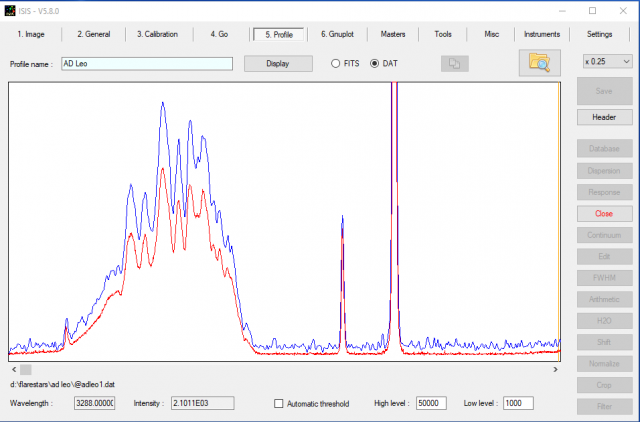Forum Replies Created
-
AuthorPosts
-
 Dr Andrew SmithParticipant
Dr Andrew SmithParticipantInteresting idea. I have taken the spectra of a red laser using an echelle spectrometer. This clearly shows that it has multiple modes. I will try a d find it.
The big boys use lasercombs but rather out of my price and capability range. While goggling them I came across an Amazon advert for cheap lasercombs but alas they were for hair.
Regards Andrew
 Dr Andrew SmithParticipant
Dr Andrew SmithParticipantI checked the date to see if were a firework! Very clear.
Regards Andrew
 Dr Andrew SmithParticipant
Dr Andrew SmithParticipantLook like a chocolate cake to me. By the way Christam is just the day before my birthday
Regards Andrew
 Dr Andrew SmithParticipant
Dr Andrew SmithParticipantEquipment and Techniques look right hand side to “Sections” links
Regards Andrew
 Dr Andrew SmithParticipant
Dr Andrew SmithParticipantHi Robin, it confirms, I think, it is better to put the effort into having hight quality data and calibration frames than to try and fix it in software.
That’s why I used an external flat source with my LISA.
Regards Andrew
 Dr Andrew SmithParticipant
Dr Andrew SmithParticipantIt looks as if it has differentiated the signal. Best to keep away from dust particles as if they fully block the slit not even a perfect flat can correct it if I remember the equations correctly.
Regards Andrew
 Dr Andrew SmithParticipant
Dr Andrew SmithParticipantThanks Robin, so as long as you don’t have any significant real vignetting it seems to be the way to go.
I will give the software a miss.
Regards Andrew
 Dr Andrew SmithParticipant
Dr Andrew SmithParticipantThanks Robin, so as long as you don’t have any significant real vignetting it seems to be the way to go.
I will give the software a miss.
Regards Andrew
 Dr Andrew SmithParticipant
Dr Andrew SmithParticipantInteresting Robin, mirrors what I found. Can you do a similar plot after applying the correction?
By the way what software are you using to do the plots?
Thanks Andrew
 Dr Andrew SmithParticipant
Dr Andrew SmithParticipantHi Robin, I was not proposing not to use the flat just that if you used the vertical gain you would lose the pixel to pixel response variations. Maybe these are less important than the ripples.
As always experiment will reveal all!
I look forward to seeing what you find.
Regards Andrew
 Dr Andrew SmithParticipant
Dr Andrew SmithParticipantI remember looking at this some time ago. If you are going to do it I think you should apply a PRNU correction to remove fixed pattern noise first. At least then you are only removing, hopefully, low frequency vignetting and non uniform illumination .
In the end I used external tungsten flats with my LISA.
Regards Andrew
 Dr Andrew SmithParticipant
Dr Andrew SmithParticipantJame kook at post 10 in the attached link https://www.aavso.org/content/best-software-very-accurate-differential-photometry-work
Maybe what you need.
Regards Andrew
 Dr Andrew SmithParticipant
Dr Andrew SmithParticipantOne change the extension to one of the allowed ones but make it clear what it shoul be.
Two if there is no animation save as pdf.
Regards Andrew
 Dr Andrew SmithParticipant
Dr Andrew SmithParticipantI have sent an email to all I think wanted to be involved. If you didn’t get it and want to be involved send me an email and I will include you.
Regards Andrew
 Dr Andrew SmithParticipant
Dr Andrew SmithParticipantHi Richard, will get back to all who have expressed an interest in a few days. Still space if others are interested.
Focus is important. Yhe Atlas can be trained for temperature compensation and The Sky X focus routines can be scripted. The carbon fibre tube of the ODK seems quite stable.
Regards Andrew
 Dr Andrew SmithParticipant
Dr Andrew SmithParticipantAt least it will stop anyone seeing an approaching UFO through that lot!
Regards
 Dr Andrew SmithParticipant
Dr Andrew SmithParticipantNASA are using a CMOS camera on their Parker Solar Probe.
I and others use them for spectroscopy without any issues. As with CCD you need to check the linearity etc.
You also need to set the gain and offset to suit. You effectively can trade off read noise for dynamic range.
Regards Andrew
 Dr Andrew SmithParticipant
Dr Andrew SmithParticipantNice clean spectrum Robin. So not so unusual as first thought. Foreground star?
Regards Andrew
 Dr Andrew SmithParticipant
Dr Andrew SmithParticipantI am sure in theory their could be some changes but they might well be of the same order as the changes between taking the flats and the observations on a given night.
I would do a set on two nights with a reasonable temperature difference. Then subtract them and see if the is a significant residual or not.
Regards Andrew
 Dr Andrew SmithParticipant
Dr Andrew SmithParticipantHere is a spectra of AD Leo an M class Red Dwarf that is known to flare. The red is 20s *107 images unfiltered and blue a single 20s exposure with a Gaussian filter set at 4 in ISIS. Not normalised or dark subtracted hence the offset and hight differences.
True rookie errors. Spectra red to blue, interloper star and not well aligned spectra to CMOS rows! Still waiting for the rotator to ease some of these issues.
Regards Andrew

-
AuthorPosts
